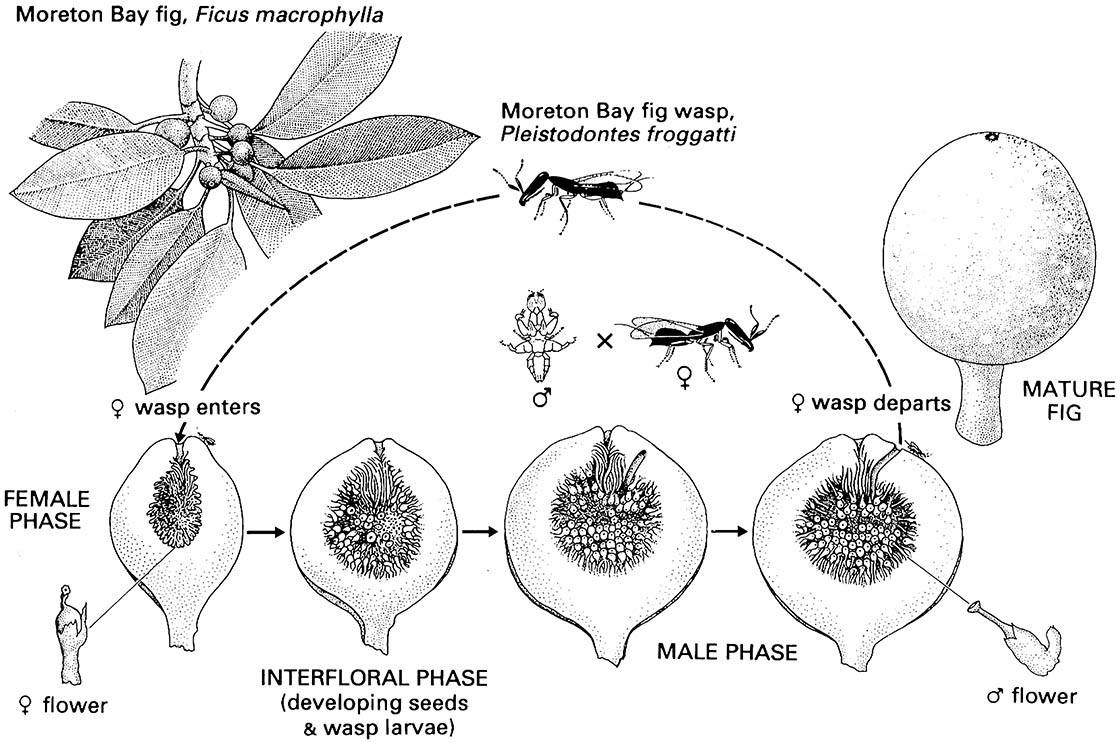Box 11.4. Figs and fig wasps
Figs belong to the large, mostly tropical genus Ficus (Moraceae) of about 900 species. Each species of fig (except for the self-fertilizing cultivated edible fig) has a complex obligatory mutualism with usually only one species of pollinator. These pollinators all are fig wasps belonging to the hymenopteran family Agaonidae, which comprises numerous species in 20 genera. Each fig tree produces a large crop of 500–1,000,000 fruit (syconia) as often as twice a year, but each fruit requires the action of at least one wasp in order to set seeds. Fig species are either dioecious (with male syconia on separate plants to those bearing the female syconia) or monoecious (with both male and female flowers in the same syconium), with monoecy being the ancestral condition. The following description of the life cycle of a fig wasp in relation to fig flowering and fruiting applies to monoecious figs, such as F. macrophylla (illustrated here, after Froggatt 1907; Galil & Eisikowitch 1968).
The female wasp enters the fig syconium via the ostiole (small hole), pollinates the female flowers, which line the spheroidal cavity inside, oviposits in some of them (always short-styled ones), and dies. Each wasp larva develops within the ovary of a flower, which becomes a gall flower. Female flowers (usually long-styled ones) that escape wasp oviposition form seeds. About a month after oviposition, wingless male wasps emerge from their seeds and mate with female wasps still within the fig ovaries. Shortly after, the female wasps emerge from their seeds, gather pollen from another lot of flowers within the syconium (which is now in the male phase), and depart the mature fig to locate another con- specific fig tree in the phase of fig development suit- able for oviposition. Different fig trees in a population are in different sexual stages, but all figs on one tree are synchronized. Species-specific volatile attractants produced by the trees allow very accurate, error-free location of another fig tree by the wasps.
Phylogenetic studies suggest that the fig and fig wasp mutualism arose only once because both interacting groups are monophyletic. Significant co-speciation has been inferred but rarely tested. For any given fig and wasp pair, reciprocal selection pressures presumably result in matching of fig and fig wasp traits. For example, the sensory receptors of the wasp respond only to the volatile chemicals of its host fig, and the size and morphology of the guarding scales of the fig ostiole allow entry only to a fig wasp of the “correct” size and shape. It is likely that divergence in a local population of either fig or fig wasp, whether by genetic drift or selection, will induce coevolutionary change in the other. Host-specificity provides reproductive isolation among both wasps and figs, so coevolutionary divergence among populations is likely to lead to speciation. The amazing diversity of Ficus and Agaonidae may be a consequence of this coevolution.




